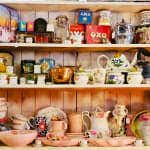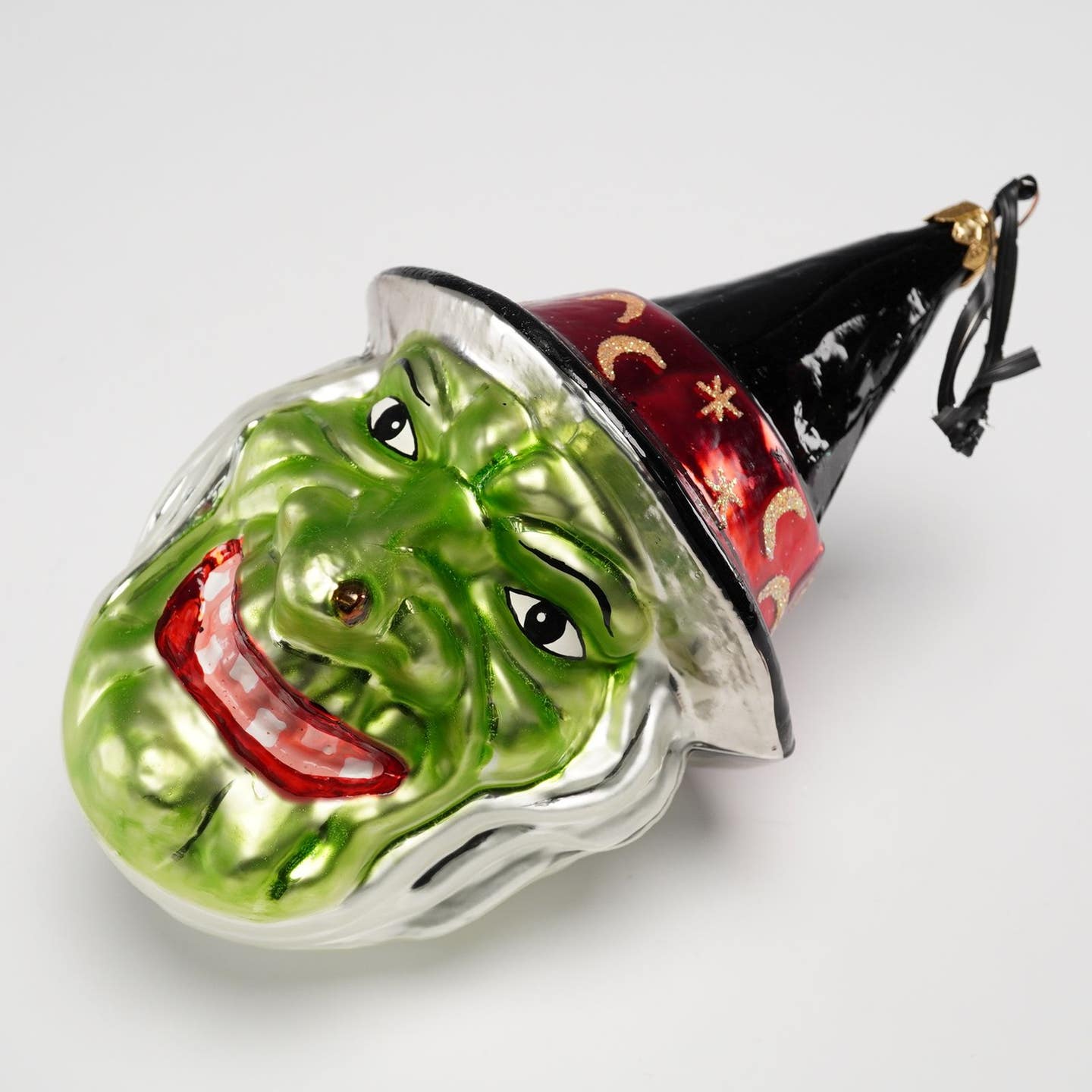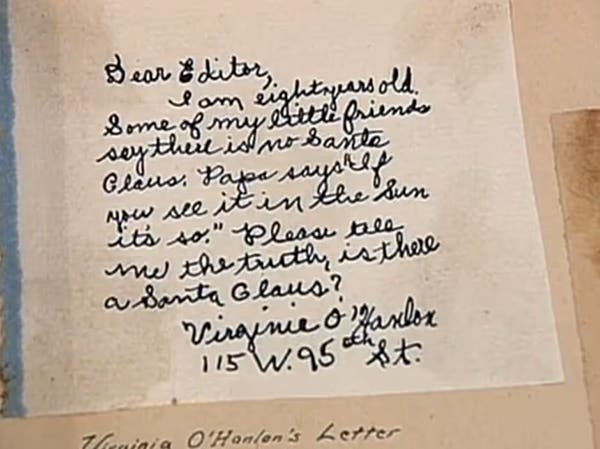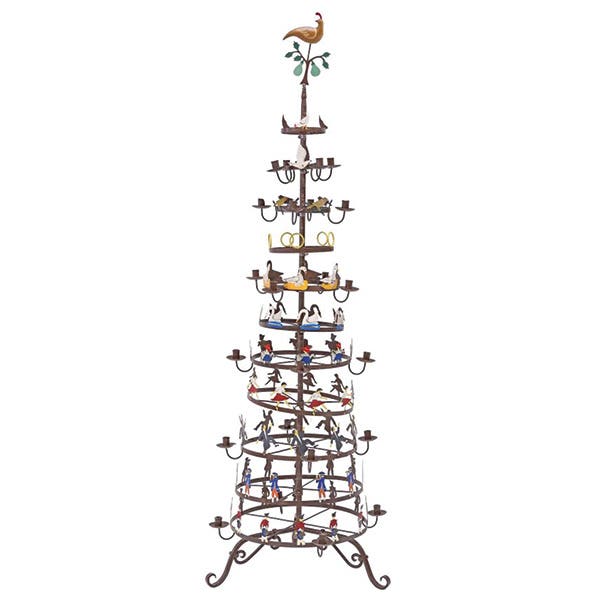Majolica Magic: Vivid Colors, Wild Forms, Enduring Appeal
From boar’s head tureens to mermaid jardinières, majolica is the gloriously weird ceramic you didn’t know you needed.
Bright, bold, and brimming with personality, majolica ceramics have captivated collectors for centuries. From whimsical cabbage leaf plates and dolphin-topped fountains to vividly glazed game tureens, this distinctive pottery style is as much a feast for the eyes as it is a window into ceramic history. While not all that glitters is true majolica, the confusion around the term has only added to its mystique.
What is Majolica?
Majolica isn’t just one thing, and that’s part of what makes it so fascinating. At its core, majolica refers to a type of earthenware ceramic that is vividly glazed and often molded in high relief. But majolica can mean very different things depending on when and where it was made.
The term originally referred to maiolica, a tin-glazed pottery style developed in Renaissance Italy and Spain. These wares were coated in a white, opaque glaze (created by adding tin oxide) and then painted with intricate designs in cobalt blue, green, and other mineral-based pigments. Maiolica is still produced in traditional pottery centers like Deruta, Italy, and Talavera de la Reina, Spain.
But in Victorian England, the term “majolica” took a new and different turn. During the 1851 Great Exhibition in London, Minton debuted a new style of pottery using brightly colored, translucent lead glazes over molded relief designs. This lead-glazed majolica was wildly popular, inspiring companies like Wedgwood, George Jones, and others to jump into production. This gave rise to the bold, often whimsical pieces many collectors associate with the word today.
The overlap in terminology—maiolica (tin-glazed) versus majolica (lead-glazed)—has led to plenty of confusion, especially since both styles share bright palettes and European roots. Add in 20th-century American ceramics labeled “majolica” and contemporary reproductions, and the lines blur even further.
The Origins of Majolica
Majolica’s story begins not in Victorian England but centuries earlier, along the sun-drenched coasts of the Mediterranean. Its roots lie in maiolica, a tin-glazed earthenware that flourished in Islamic Spain and was later refined by Italian artisans during the Renaissance. These Italian works often featured historical, biblical, or mythological scenes called istoriato wares (painted with stories).
Image courtesy fineart-restoration.co.uk
The name “maiolica” is believed to derive from the island of Majorca, a key stop on trade routes between Spain and Italy. From there, Spanish tin-glazed wares traveled to the Italian mainland, where pottery centers like Faenza, Urbino, and Deruta adapted and elevated the style. These early maiolica pieces were prized for their white, opaque glaze, made possible by the addition of tin oxide, which provided the perfect canvas for detailed narrative scenes, coats of arms, and botanical motifs rendered in brilliant blues, greens, and ochres.
Meanwhile, across the border in France, potter Bernard Palissy developed his own distinctive take on majolica in the 16th century. Famous for his rustique ceramics (also called Palissy ware) teeming with frogs, lizards, snakes, and fish, Palissy is believed to have pressed real, once-living specimens into clay to create hyper-realistic molds. Once fired and glazed in earthy, jewel tones, the results were strikingly realistic and slightly macabre. Palissy blurred the line between art and nature and cemented his legacy as both an innovator and a bit of a mad genius.
Though rooted in the Renaissance, the influence of these early tin-glazed traditions persisted well into the 18th and 19th centuries, laying the groundwork for majolica’s Victorian-era rebirth. It wasn’t until the Industrial Revolution, however, that the style was adapted for mass production and embraced by middle-class consumers on both sides of the Atlantic.
Victorian Revival and British Boom
While the roots of majolica can be traced back to the Renaissance (and beyond), the Victorians catapulted it into mass-market fame. At the 1851 Great Exhibition in London, Minton & Co. unveiled a bold new ceramic style that dazzled attendees: richly molded earthenware glazed in translucent, jewel-toned lead colors. Inspired by Italian maiolica and French Palissy ware but made uniquely British. This was the birth of what collectors now call Victorian majolica.
The timing was perfect. The Industrial Revolution revolutionized ceramic manufacturing, allowing for more consistent molding, mass glazing, and large-scale production. Minton’s majolica quickly caught on, not just for its beauty but also for its whimsy. Pineapple teapots, begonia leaf plates, and garden seats shaped like monkeys—no subject was too fanciful. Major players like Wedgwood, George Jones, and Samuel Lear soon followed, each with their own unique flair.
Victorian majolica was primarily lead-glazed, not tin-glazed like its Italian forebearers. This technique made the pieces glossy, vibrant, and affordable, a far cry from the hand-painted majolica of earlier centuries. By the late 19th century, majolica was made across England and exported globally. However, changing tastes, concerns over lead glazing, and evolving production methods eventually pushed it out of fashion by the early 20th century.
Yet collectors today remain enchanted by the sheer creativity of this period. Pieces from makers like Minton or George Jones still command top dollar at auction, especially when they're in good condition and feature rare forms.
Majolica Production Today
While the Victorian majolica craze eventually faded, the art form never truly disappeared. Several regions around the world have continued to produce majolica. Some stay true to their historical roots, while others blend tradition with a contemporary flair.
Italy remains a global hub for majolica production, especially in the towns of Deruta, Faenza, Vietri sul Mare, and Gubbio. Here, artisans still create tin-glazed ceramics using centuries-old techniques, often under the label maiolica. These pieces usually feature the classic white glaze base adorned with hand-painted Renaissance-style motifs, floral patterns, or scenes from Italian folklore.
Spain continues its long-standing tin-glazed pottery tradition, particularly in Talavera de la Reina and El Puente del Arzobispo. Recognized for their cobalt-blue decorations and intricate geometric designs, Talavera ceramics are both a cultural staple and a collectible export.
Portugal boasts a vibrant majolica tradition centered in Caldas da Rainha. The region is famous for its colorful figural ceramics and naturalistic motifs, such as cabbage-shaped soup tureens or trompe l'oeil (French for “deceives the eye”) fish platters—many of which are still handmade today using 19th-century molds.
Mexico has become a major producer of majolica by adapting Spanish colonial techniques. Certified Talavera pottery from Puebla (a protected designation of origin) combines indigenous and European aesthetics, often with bold hand-painted designs and traditional forms.
United States studio potters and artisan workshops continue to produce majolica-style wares, usually lead-free and with modern glazes. Though they may not fit the historical definition, these pieces often mimic the vivid color palette and whimsical charm of 19th-century examples—and contribute to the ongoing confusion over what “majolica” means.
Rarity and Value (With a Few Collector Tips Thrown In)
Majolica may have been mass-produced in its heyday, but, as collectors know, not all pieces are created equally. Rarity often hinges on form, maker, condition, and how well a piece survived the past century or more. Unusual shapes like rabbit tureens fashioned from vegetables, monkey-handled teapots, and the Delphin Massier Grasshopper Vase are highly sought after, as are items from top-tier manufacturers like Minton, George Jones, and Wedgwood.
The item’s condition is key. Chips, cracks, crazing, and restoration can significantly affect value, although, for especially rare pieces, even damage doesn’t always scare off determined collectors. The best pieces boast vibrant glaze, sharp relief details, and minimal wear. Mold marks, registry numbers, and impressed or incised marks can help with attribution, though not all pieces are labeled.
Recent auctions have shown strong demand for standout examples. A Minton lobster salt cellar might fetch thousands, while more common asparagus plates might land in the $100–$300 range depending on maker and condition. Decorative majolica continues to draw interest, especially pieces that balance whimsy with craftsmanship.
Collectors should also beware of reproductions, especially brightly colored wares from the 20th century that mimic majolica’s aesthetic without its materials. True Victorian majolica is lead-glazed and often quite heavy; many modern versions use lighter materials and glossier, less nuanced glazes. Reproductions frequently feature bright primary color (to the point of garishness) and opaque, drippy glazes that may puddle on the interior bottom of the piece. The sides of the items are frequently thinner, and the exterior design will be seen on the sides when looking down into the piece (most especially vases and pitchers). A thick rim or lip is commonly seen. The underside may have a thick, clumsy-looking foot and what appears to be a registration mark, but those are often forged. The craftsmanship is generally noticeably lacking. When in doubt, consult reference books, reputable websites, or dealers with deep knowledge in the field.
Whether investing in high-end pieces or building a collection around the sheer joy of the form, majolica continues to enchant collectors. It offers something for nearly everyone, including history, artistry, and, if you’re into the odd and unusual, just the right touch of eccentricity.
You may also like:








